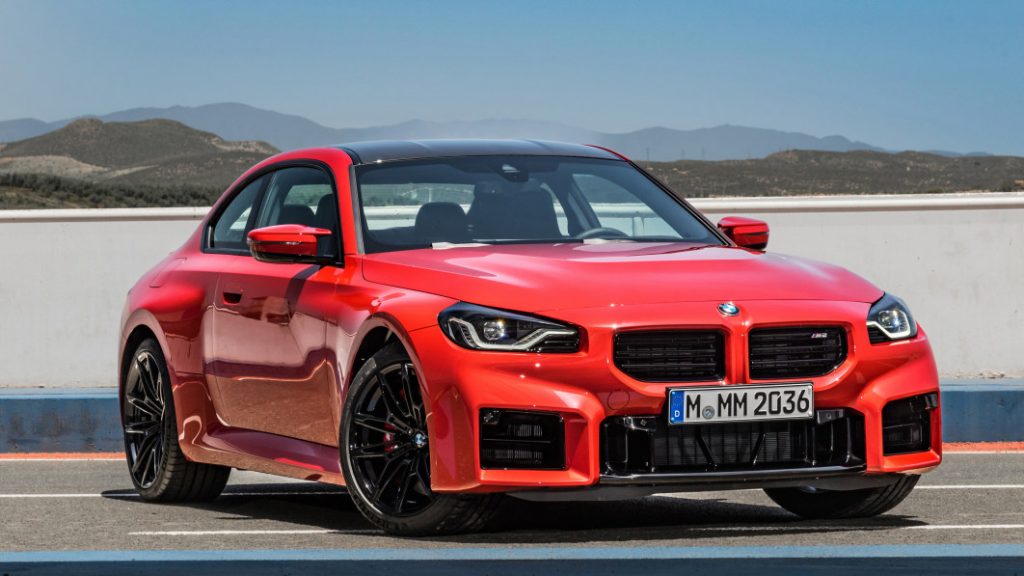2023 BMW M2 is bigger, heavier, meaner, and did we mention heavier?

We knew from camouflaged prototypes that the 2023 BMW M2 would be a seriously chunky boy. Now that the new coupe’s edges and angles have been bared, it’s clear we got the chunk right but we didn’t consider the pocket Hulk intensity. BMW designers were intent on making a statement with the debut of the brand’s last non-electrified M car, starting with a low, wide front fascia exaggerating all the horizontals. Leaving the M2 CS design language behind, straight lines and hard edges dominate. A stretched, frameless kidney grille separates stretched, single-element LED headlights. A pair of deep creases distinguish the upper area from the triple lower intake that is all rectangles, each element pulled laterally across the car.
The design softens slightly from there, the sides dominated by wheel arches bulgy enough for the M2’s track to match the BMW M4, at 63.7 inches in front (+1.5 inches over the previous M2) and 63.2 inches in back (+0.16 inch), as well as matching the M4’s 74.3-inch width. The other dimensions are a 180.3-inch width, 4.1 inches longer than before; a 55.2-inch height, 0.3 inch lower than before; on a 108.1-inch wheelbase, 2.1 inches longer than the last M2. The extra distance between the wheels makes for more legroom in front and back, but we still wouldn’t expect to put anyone we liked in the second row for long.
The rear fascia exaggerates elements from the earlier car. A more pronounced crease sets off the decklid spoiler. The lower edge of the trunk doesn’t cascade into the bumper anymore, rather, the two meet with straight lines, the bumper drawn like a jutting crossbar. Slim outer air vents are gone, pried open to form vertical rectangles housing reflectors. The diffuser insert looks to be merely that, a decorative insert to frame quad pipes emerging from a wide muffler. It is all very serious.
M’s signature engine sits under the long hood, the S58 TwinPower Turbo inline six-cylinder. Puissance comes to 453 horsepower and 406 pound-feet of torque, 48 horses more than the M2 Competition, nine more than the M2 CS, with the same torque figure shared between the three. The turbo six hits those numbers at slightly higher rpms than before, peak horse at 6,250 rpm instead of 5,230 rpm in the former M2 Competition, peak torque at 2,650 rpm instead of 2,350 rpm. The redline comes at 7,200 rpm.
Every bit of that goes to the rear wheels through either a six-speed manual transmission or an eight-speed automatic. Those wheels are now staggered; instead of wearing 19-inchers all around, a pair of Jet Black 19-inch light alloy wheels in 275/35 rubber hang off the front axle, a pair of 20-inch light alloy wheels shod in 285/30 rubber hang off the back. The larger contact patch is really about improving handling more than acceleration. BMW says 0 to 60 miles per hour takes 3.9 seconds in the automatic, 4.1 seconds in the manual. The M2 CS with the seven-speed dual-clutch automatic ran the same sprint in 3.8 seconds, the M2 Competition with the same gearbox did it in 4.2 seconds. These close times are definitely related to the fact that BMW lists curb weight for the new second-gen M2 at 3,814 pounds with the manual gearbox, 3,867 with the automatic. The previous M2 weighed 3,600 pounds with the six-speed manual.
Standard performance aids to make the most of the go will include rev-matching Gear Shift Assistant on manual-equipped cars, the Active M Differential, Adaptive M Suspension, dual-mode steering, and M Drive Professional with ten traction control settings. Reigning everything in, the dual-mode braking system gets a set of six-piston brakes clamping 15-inch discs in front, single-piston calipers clamping 14.6-inch rotors in back.
The interior gets redesigned M Sport Seats with more aggressive side bolsters, stitched up in perforated in black or cognac Vernasca leather and set off with illuminated M logos. An optional Carbon Package swaps out for a set of new M Carbon bucket seats that save 24 pounds over the M Sport Seats, while keeping amenities like Merino leather, electric adjustment, seat heating, and illuminated M2 badges. The Carbon Package also gets the weight saving carbon roof instead of the glass moonroof that’s 20% larger than before, carbon shift paddles for the automatic-equipped models, and carbon trim throughout the cabin.
Standard convenience and safety systems include Park Distance Control, Dynamic Cruise Control, Front Collision Warning with brake intervention, and Lane Departure Warning. Active Cruise Control with Stop & Go can be optioned only on cars with the eight-speed auto. The standard color palette gets Alpine White, Black Sapphire metallic, Brooklyn Grey metallic, Toronto Red metallic, and the M2-exclusive Zandvoort Blue.
The new M2’s global launch will come in April 2023. Starting price will be $62,200 plus a $995 destination charge, totaling $63,195, about $3,300 more than the last-gen.



